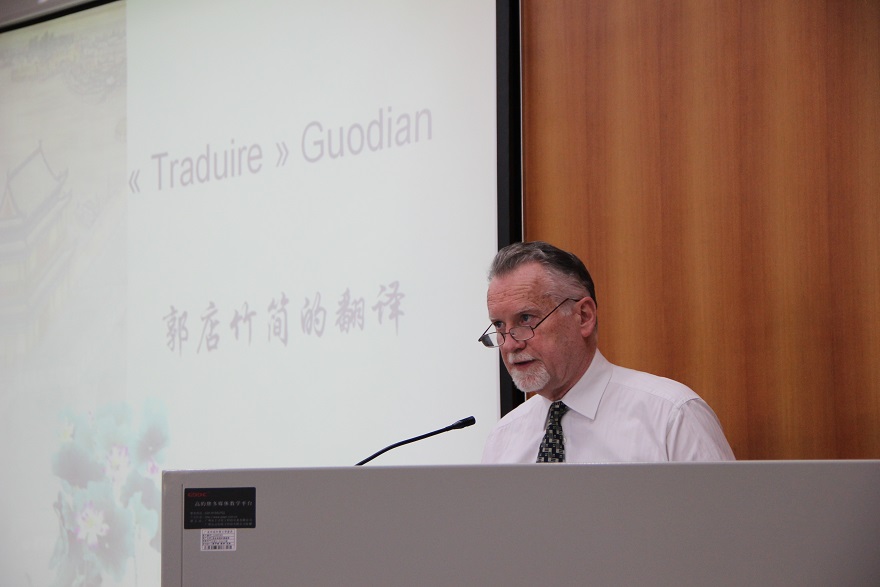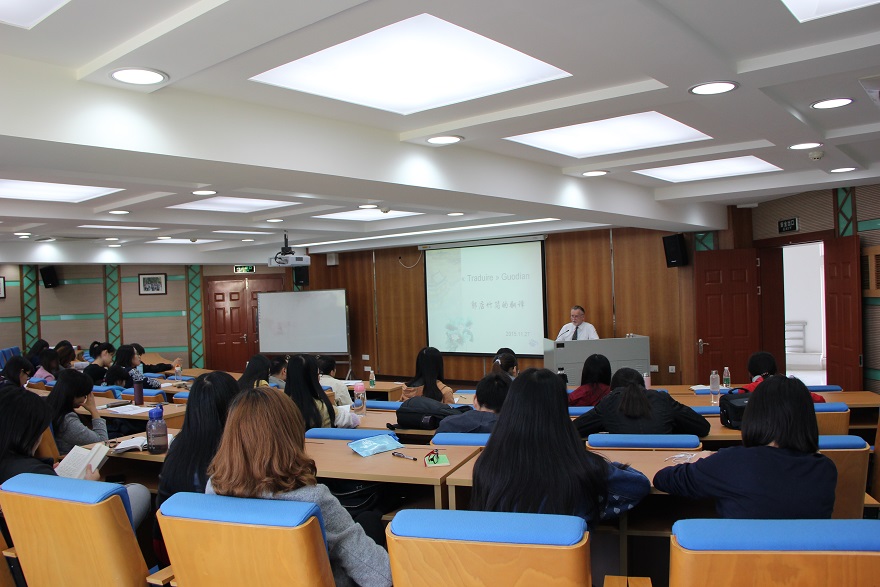On the afternoon of November 27th , Rémi Mathieu, a famous French sinologist and a senior researcher of the Research Institution of East Asian Culture of CNRS (The French National Center for Scientific Research), visited GDUFS and delivered a speech at the Huanghua Hall in Building Nine, north campus of GDUFS. The topic of his speech was about how to translate the Guodian bamboo slips.
Professor Rémi Mathieu firstly introduced the background of the discovery of Guodian bamboo slips. In the year of 1993, Guodian bamboo slips were discovered at the No.1 Guodian Chu Tomb in Guodian Village, Jingmen City, Hubei Province. More than 804 bamboo slips were unearthed, which can be dated back to the end of the 4th century BC. These bamboo slips included 16 philosophical classics, most of which were Confucian classics, and two articles of Laozi. Therefore, the translation of Guodian bamboo slips plays a good guiding role in researching Confucianism and Taoism and has important significance in Chinese ideological history. However, in order to do a good translation of bamboo slips, we firstly need to stride over language obstacles, and understand the original text very well and the cultural information across the ages behind the words.

Professor Rémi Mathieu introduced the Guodian bamboo slips
However, there exists two obstacles in reading bamboo slips. Firstly, the words engraved on the Guodian bamboo slips came from the Chinese state of Chu, which are not easily recognized. Secondly, the Guodian bamboo slips were scattered and mutilated when unearthed. Although the bamboo slips were divided into different chapters, and the connections between the chapters were analyzed, it was still difficult for researchers to fully recover their original appearance. Undoubtedly, these problems increased the difficulty of translating the bamboo slips, because the biggest problem was not understanding the meaning of the articles, but confirming the content of every article. Based on these two problems, Mathieu began to research the translation of Guodian bamboo slips from the perspective of etymology and lexicology. He devoted himself to translating the content of Guodian bamboo slips to readers who speak French.
At the same time, Mathieu also devoted himself to researching the Confucianism contained in the Guodian bamboo slips. Researchers of Confucianism had always thought that the two Confucian maters, Confucius and Mencius, were 200 years apart and that Confucianism was not well developed and inherited. Hence, the discovery of Guodian bamboo slips exactly filled in this blank and connected Confucianism and Taoism. The bamboo slips especially summarized and concluded the characteristics and content of Mencius school, among which the articles The Five Elements, Nature from Fate, and The Books of Rites all deeply discussed some basic problems in Pre-Qin Confucianism, such as: the relation between heaven and man; benevolence-internal and justice-external; benevolence and finial piety; sincerity and truthfulness; the promotion of self-cultivation, and so on. Professor Mathieu explained these contents in detail for all students and teachers.

The scene of the lecture
Appendix:
Rémi Mathieu, the director of the Research Institution of East Asian Culture of CNRS (The French National Center for Scientific Research) and a senior researcher, has published more than 20 books. His research contents mainly involved Chinese classical thought, especially Chinese mythology, philosophy and Pre-Qin literature. Chinese Poetry Anthology, compiled with his guidance, has been published recently. At present, he is in the process of researching and translating the bamboo slips unearthed at Guodian, Hubei Province.
Chinese Report: 法国著名汉学家雷米•马修讲解郭店竹简